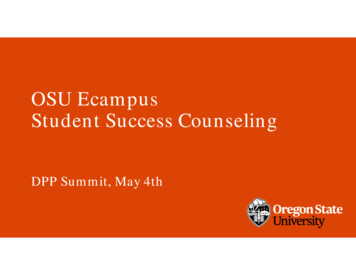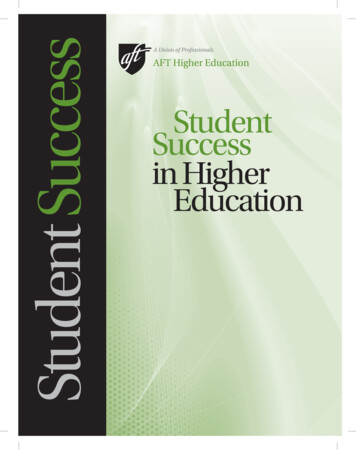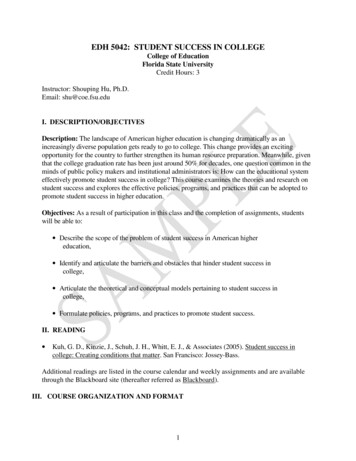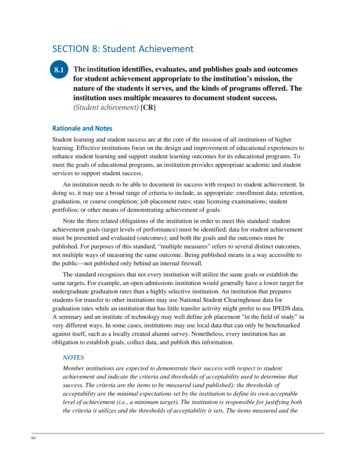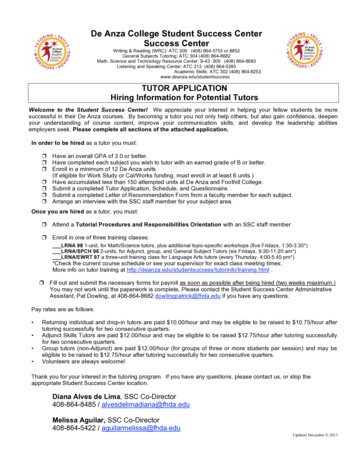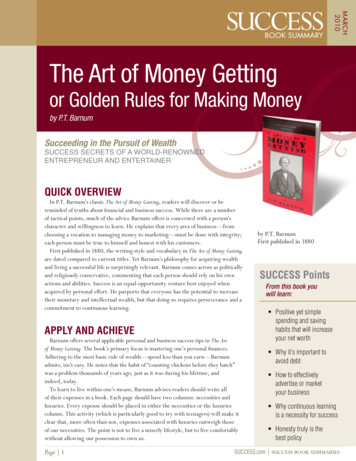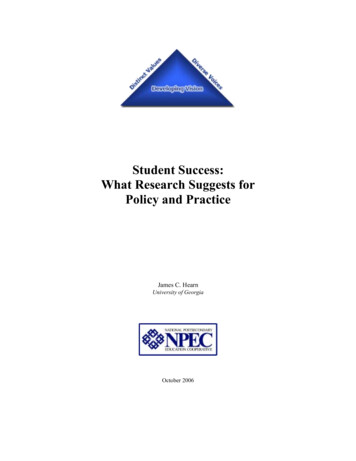
Transcription
Student Success:What Research Suggests forPolicy and PracticeJames C. HearnUniversity of GeorgiaOctober 2006
STUDENT SUCCESS:WHAT RESEARCH SUGGESTS FOR POLICY AND PRACTICEEXECUTIVE SUMMARYPolicymakers and educational leaders increasingly seek answers to a pressing question: howbest to ensure that the nation’s colleges and universities are effectively addressing their most criticalresponsibility, the education of undergraduate students. The attention to student success reflects morethan a personal concern for students—it also reflects a growing sense that the nation itself is faced withfiscal, demographic, and competitive challenges demanding the best educational system possible.This essay addresses the findings and implications of five reports commissioned by theNational Postsecondary Education Cooperative (NPEC) and scheduled for presentation and discussion ata national symposium in November 2006.The reports were each aimed toward reviewing andsynthesizing the diverse research literature on student success, articulating a persuasive, inclusive theoryinformed perspective on success and its correlates, identifying significant issues and problems in theliterature, and incorporating multilevel perspectives on the research and its application.Some themes are common to the authors’ conclusions in these five reports. Student success in postsecondary education has roots in students’ lives far earlier thanthe postsecondary years, through the influences of families, peers, teachers, counselors,cultural factors, and K–12 school curricula and extracurricula. Specific on-campus factors important for postsecondary success include highexpectations (as manifested in curriculum, climate, and teaching practices); coherence inthe curriculum (i.e., in required courses and sequencing of courses); integration ofexperiences, knowledge, and skills; opportunities for active learning; assessment andfrequent feedback; collaborative learning opportunities; time on task; respect fordiversity (race/ethnicity/cultures, talents and abilities, ways of knowing and learning);frequent contact with faculty; emphasis on the first-year experience; and thedevelopment of connections between classroom work and learning opportunities outsidethe classroom. Classrooms and teaching faculty provide the most direct organizational influences onpostsecondary student success, with governmental and institutional policies andpractices playing notable indirect roles. Policy integration and coordination across and within postsecondary programs,departments, institutions, and systems facilitates student success.
Policy integration and coordination between the postsecondary and K–12 educationlevels facilitates student success. Programs, institutions, systems, and states should engage in significant, continuousinformation gathering, measurement, and assessment relating to student success. Policymakers and institutions should support research and theory development targetedat student success, including its multiple aspects, the various theoretical perspectives onit, ways to measure and assess it, the factors that shape it, differences among studentbackgrounds as precursors to it, and programmatic approaches to achieving it for allstudents.Beyond these common conclusions, the reports exhibited some notable differences inemphasis. Among the topics addressed in detail by some but not all of the reports were state financingpolicies for institutions, governments’ need-based student financial aid programs, the state role inensuring academic quality, the special role of institutional leaders in creating a climate for success,faculty hiring and reward systems, the optimal approach to counseling students on major choices, thecentral role of academic major programs, approaches to dealing with group-level student differences insuccess policies, the appropriateness of narrow vs. wide definitions of student success, the role of campuslearning communities in success, and the value of comprehensive theoretical visualizations of thedevelopment of student success.Several topics were covered only in limited ways in the five reports, no doubt largelybecause of the absence or inferiority of available data and prior research. Clearly, these limitations shouldnot take these topics off of researchers’ and policymakers’ agendas.Perhaps most fundamental of all the topics meriting continuing emphasis and attention is thequestion of effectively defining and measuring student success. Graduating with a desired degree isunquestionably an appropriate indicator of a student’s success, and aggregated institutional and systemrates of graduation can be a significant indicator of an institution’s or system’s performance. Simple andstraightforward, graduation rates are very much on the minds of policymakers, educational leaders, thepublic, and students themselves.But institutions differ in the capabilities of their students to do college work. A focus on rawgraduation rates runs the risk of embellishing the reputations of selective schools while tarnishing theperceptions of those serving a wider range of students. There are other limitations to graduation rates, aswell.Notably, student intent does not always coincide with the assumptions behind focusing ongraduation rates. Some students attend only to build academic credits toward transferring to anotheriv
institution or to obtain job-related competencies, laudable academic goals that, if pursued in largenumbers, might threaten institutions’ degree-completion rates.Policymakers wanting to avoid simplistic public assessment of institutional and systemwideperformance need thoughtful supplements to the obvious choice of graduation rates. These new choicesmust be understandable, measurable, cost-effective, and reflective of core policymaker concerns. Amongthe new success indicators are measures of the intellectual qualities of those who have obtained or areabout to obtain the degree. There is debate, however, over whether assessments targeting critical thinkingare more appropriate than assessments targeting the factual knowledge gained in courses. Whatever theanswer, with appropriate funding and designs, these approaches can take into account the enteringcharacteristics of students at institutions, and thus reduce biases toward finding only the most selectiveinstitutions meritorious.New student success indicators might also focus on the extent to which students, regardlessof degree attainment, are prepared for jobs with solid prospects and earnings potential, enter jobs servingsociety’s needs, find employment after attendance, achieve financial literacy, gain understanding ofsocial, economic, and political issues, become civically engaged, have the basic understanding of scienceand technology necessary for contemporary citizenship, acquire appropriate certification or licensure foremployment, develop intercultural and global understanding, and appreciate and pursue lifelong learning.Each of these indicators could be estimated for students who have completed any amount of study, andthus could lessen the focus on degree attainment and graduation rates.Another tack might build upon quantitative measurement of students’ intent and satisfaction.Did students meet their initial goals in entering the institution? Are they satisfied with their learningexperiences? While some might see such data as “soft,” they would address the converse problem with“hard” graduation data: the temptation to assume that we understand the reasons for students’ choices tostay on campus or leave. Considering soft and hard data in concert seems preferable to relying solely ongraduation-rate data, and thereby implicitly assuming that students not graduating from their initialinstitution represent failures on that institution’s part.Realistically, all of these supplemental approaches face two hurdles. First, the variousfactors may not all be amenable to the development of indicators meeting the criteria of beingunderstandable, measurable, cost-effective, and reflective of core policy concerns. Second, assuming thatacceptable indicators of various supplemental domains of success can be devised and implemented, howcan any institutional and systemic assessment system take into account not only the diverse enteringcharacteristics of each institution’s students but also the unique history and mission of the institutionv
itself? That is, each of the alternative definitions proposed above is vulnerable to the criticism that it mayprivilege certain kinds of institutions and missions over others. What seems readily apparent, though, isthat considering a varied array of indicators, even with the inevitable imperfections of each, is preferableto focusing on only one imperfect indicator.Beyond these questions of definitions and indicators, the reports do not delve intensivelyinto some other important issues: The specific ways student motivations, aspirations, and values develop and shapesuccess in postsecondary education; The influences of broad societal structures on students’ chances for success; The challenges of implementing student success policies; State and federal politics; Institutional financial aid policies; State mission-differentiation efforts; Success among students in for-profit and online programs; Success among commuting and part-time students; Differences in educational achievement processes among students from variedsocioeconomic, ethnic, racial, cultural, and age populations; Information and emerging information technologies as factors in student success; and The potential role of integrated, longitudinal student-record databases in providingsupplemental indicators of student success.There is obviously much still to learn concerning student success. What is more, thedevelopment of productive dialogue and the consequent implementation of effective policies andprograms to improve rates of student success are not likely to be easy matters. With the goal of furtherspurring movement from research to action, NPEC invited written responses to the five commissionedpapers from leading educational researchers, leaders, and policymakers. Reviewing the reports andcorresponding responses as a whole, one can identify a number of potential nontrivial challenges awaitingthose who wish to move ahead intelligently in improving students’ odds of success.vi
A first, critical challenge involves dealing with the deceptive allure of efficiency. Reducingattrition rates at the system and institutional levels represents a clear-cut achievement toward greaterstudent success, for example, but approaches to that goal may require de-emphasizing other goals, such asexpanding access for students disadvantaged by prior educational experiences.Awareness of themultiple, and sometimes conflicting, goals of postsecondary institutions is central to a measured approachto success.Another likely challenge in discussions of student success involves the potential appeal togovernmental, accreditation, and association officials of pursuing the “one best solution.” In the midst ofall the attention to student success nationwide, there may be a natural tendency to try to identify “thebest” approach for achieving student success. Such efforts may be laudable and useful, but there is reasonto be cautious about any hints of universal applicability and effectiveness. It may not be a bad thing thatno single policy approach appears to be emerging as dominant. In fact, it is clear that complicated anddiverse problems of student success are likely to require complicated and diverse solutions, fitted to thecomplicated and diverse individual institutional settings of postsecondary education in this country.There are unquestionably better and worse ideas afloat, and public evaluation should always work towardensuring that good ideas drive out the bad.Nonetheless, the notion that any one policy idea isunequivocally best is shortsighted. There are unlikely to be any “magic bullets” awaiting those seeking toraise students’ chances of success.A further threat to productive dialogue and action involves glibness. For example, it is fareasier to support, in the abstract, integrative policy development across levels of the education systemthan to achieve that integration in reality. The most productive dialogue on success will be realisticconcerning the difficulties of achieving some desired structural and political outcomes.It is especially important to guard against any tendency to speak about the desirability ofstudent success abstractly rather than as an area of potential investment of scarce resources, to beanalyzed rigorously like any other area of potential investment. The proper questions to be asked are notabstract: to achieve real improvement in student success, and not just rhetorical victories, it is imperativethat questions of cost-effectiveness be addressed. Which outcomes may be achieved at what level ofcosts? What are the opportunity costs of choosing x rather than y? What would be the return toreforming or discarding certain existing policies and practices? Asking tough questions about costs andeffects is critical, especially in times of tight resources at both the institutional and system levels.As the preceding observations suggest, the challenges to effective action on student successare daunting. The complexity of the problem might deter taking any action at all, out of fear of waste or,vii
worse, of harm. Yet inaction also represents a clear danger. Sometimes, it makes good sense to act ratherthan simply to await the definitive, final piece of information. Often, by the time all the “necessary”information is available, the opportunity for productive action has passed. To simply recommend moreresearch as the answer to questions regarding student success may be to deny current studentsopportunities for improved campus experiences and outcomes.Thus, the best dialogue on student success is going to be dialogue that incorporates researchknowledge but also goes beyond arguments regarding the limits and fringes of that knowledge.Ultimately, the best dialogue will move policymakers and institutional leaders toward active commitmentto applying existing knowledge to the benefit of all students.viii
STUDENT SUCCESS:WHAT RESEARCH SUGGESTS FOR POLICY AND PRACTICEPolicymakers and educational leaders increasingly seek answers to a pressing issue: howbest to ensure that the nation’s colleges and universities are effectively addressing their most criticalresponsibility, the education of undergraduate students. This attention to student success reflects morethan a personal concern for students—it also reflects a growing sense that the nation itself is faced withfiscal, demographic, and competitive challenges demanding the best educational system possible.The simplest response to these challenges is for policymakers and leaders to imposeaggressive measurement and assessment techniques, as well as the strict discipline of the marketplace, topromote the flow of funding toward institutions and academic units performing well on success indicatorssuch as student graduation rates and test scores. That approach might ultimately pay off, but it reflects anarrow conception of the problem. Importantly, appropriate standards for success may vary acrossdifferent kinds of students and different kinds of educational settings.Thus, defining student success and effectively measuring it at the student and institutionallevels is not nearly as straightforward as it might seem.For example, comparing institutions’undergraduate graduation rates and rewarding those with the highest rates may disadvantage certain kindsof students and certain kinds of institutions. Ultimately, this approach could lessen the chances foreffective policy development favoring all students’ success. Consider an open-admissions institution: inwelcoming all students to its campus, the institution must deal with the students as they come, eventhough its graduation rates might well improve if it required its students to have greater educationalreadiness out of high school. Are the institution’s low graduation rates de facto evidence that theinstitution itself is failing, or should our thinking on institutions’ roles in student success take into accountthe quality of students’ preparation prior to entering postsecondary education? Perhaps the “value-added”by the efforts of the open institution is actually greater than the value added by some more selectiveinstitutions with higher graduation rates.1Such considerations have led some policymakers and leaders to realize that the answers toseemingly straightforward educational questions, such as “How can we promote student success?” turnout not to be so straightforward after all. One might not instinctively turn to academic researchers tosimplify such a complex issue, but one might indeed turn to researchers to learn more about themagnitude of the issue, alternative perspectives on the issue, applicable knowledge regarding the issue,1A recent New York Times article highlighted the controversies surrounding institutional graduation rates (Finder, 2006).1
gaps in our knowledge about the issue, and, perhaps, even possible solutions to the issue. With thatrationale as a foundation, the National Postsecondary Education Cooperative (NPEC) solicited proposalsin 2004 for comprehensive reviews and analyses of the literature on student success in postsecondaryeducation.Context for the Commissioned ReportsA number of parallel developments made NPEC’s student success initiative timely andimportant for decisionmakers at the federal, state, and institutional levels.Notably, escalatingaccountability pressures requiring colleges and universities to demonstrate student success, the increasingsize and diversity of student populations in times of scarce resources, the shift in the financing ofpostsecondary education toward students and their families, and dramatic changes in global labor marketseach point toward a need for greater attention to student success. Clearly, student success as a policyissue encompasses not only grades and degree attainment but also the nature of students’ preparation forpostsecondary education, student access, the support that institutions and others provide to students, andpreparation for careers after postsecondary education.2A major objective of NPEC’s success initiative has been to help ensure innovative, effective,and ongoing attention to postsecondary student success.3 Thus, NPEC solicited the commissioned reportsto develop persuasive, inclusive, and theory-informed perspectives on student success in postsecondaryeducation, acknowledging that success may be variously defined in different institutions and amongdifferent students. Specifically, each commissioned report would: Review and synthesize relevant research, practice, and policy literature relating tostudent success in postsecondary education, with the goals of articulating a persuasive,inclusive, and theory-informed perspective on student success and identifying studentand institutional characteristics associated with different definitions of success. Identify relevant major domains and themes in this literature. Identify significant issues, problems, and gaps in the literature’s assumptions, coreconcepts, theories and hypotheses, measurement approaches, research activity andfindings, and applications to practice and policy.2This broad view of student success, and U.S. postsecondary quality, was adopted by the recent Commission on the Future of Higher Education,formed by the U.S. Secretary of Education (see dex.html).3NPEC’s student success initiative also features competitively awarded focused-research grants and other activities.2
Incorporate federal, state, institutional, and student perspectives in developingapproaches for addressing these issues, problems, and gaps. Include attention to further developing definitions and understanding of student success,and examining the implications of the various definitions for improving practitioner andpolicymaker decisions relating to student success in postsecondary education and forfuture research and theory.In response to this solicitation, the Cooperative received numerous high-quality proposals.Using the above criteria, the NPEC review team selected four proposals for funding. The winningproposals came from John Braxton of Vanderbilt University, from George Kuh and colleagues fromIndiana University, from Scott Thomas of the University of Georgia and Laura Perna of the University ofMaryland (Perna subsequently moved to the University of Pennsylvania), and from Vincent Tinto ofSyracuse University and Brian Pusser of the University of Virginia. As additional resources becameavailable, NPEC selected for funding a fifth, more specialized, proposal from John Smart of theUniversity of Memphis, Kenneth Feldman of SUNY at Stony Brook, and Corinna Ethington of theUniversity of Memphis.In November 2006, these authors’ commissioned reports will be featured at a nationalsymposium in Washington, DC. A prominent feature of the symposium will be invited responses to thecommissioned reports prepared by leading educational researchers, leaders, and policymakers, includingDonna Alvarado of Aguila University, Thomas Bailey of Columbia University, William Demmert ofWestern Washington University, Bridget Terry Long of Harvard University, Laura Rendón of Iowa StateUniversity, Earl Richardson of Morgan State University, and Piedad Robertson, formerly of theEducation Commission of the States.4Ideally, the five commissioned reports and the invited responses to them will encourageattention, dialogue, and informed decisionmaking regarding postsecondary student success. The appendixto this essay provides summaries of the five reports. In the essay itself, I will highlight some commonthemes across the reports, identify some differences among the reports, note some areas meriting moreresearch emphasis, address challenges to achieving student success, and close with some suggestions formaking the ensuing dialogue and policy action as productive as possible.4In this essay, I refer frequently to the respondents’ comments on the five commissioned papers. As are the reports themselves, these papers areavailable online on the symposium website: http://nces.ed.gov/npec/symposium.asp.3
Discerning Common Themes Across the Five ReportsThe principal investigators for each of the commissioned projects were already respectedcontributors to the published knowledge concerning student success. It is not surprising, therefore, thatthe four comprehensive reports share some common sources in the literature, take some parallelperspectives on student success, and draw some similar conclusions regarding next steps for policy,practice, and research. What is more, the specialized report by Smart, Feldman, and Ethington, sharesmuch with the other four. This notable overlap may comfort those worried that there might be noconsensually established knowledge base in this area. Indeed, a broad consensus is apparent alongseveral dimensions.First, although each report took a different tack on the overall topic, all acknowledged thatstudent success in postsecondary education has roots in students’ lives far earlier than the postsecondaryyears, through the influences of families, peers, teachers, counselors, cultural factors, and K–12 schoolcurricula and extracurricula. The evidence for this perspective is incontrovertible.5 Students come topostsecondary education differing in their socioeconomic resources, cultural backgrounds, levels ofacademic preparation, capabilities, experiences with families and peers, intellectual and socialorientations, expectations and aspirations, and personality types.These personal and contextualdifferences affect whether students are likely to enroll in postsecondary education, the kinds ofinstitutions students are likely to consider, and the institutions students will enter.Indeed, the reports agree that social, cultural, economic, and psychological factors rooted inearlier years continue to affect student success in the postsecondary years. Contrary to the popular viewof postsecondary education as a powerful assimilating and mediating force in the lives of Americans,capable of removing the influences of youthful circumstances, the fact is that such influences rarelydisappear into the background during the postsecondary years. Thus, success initiatives that treat allstudents exactly the same (e.g., living-learning communities for all first-year students), as well as successinitiatives based entirely on students’ academic characteristics (e.g., summer preparation programs forincoming first-year students identified as “at-risk”), may fail if they are insensitive to these enduringnonacademic differences.Second, the authors consistently noted that specific on-campus factors important forpostsecondary success include high expectations (as manifested in curriculum, climate, and teachingpractices); coherence in the curriculum (i.e., in required courses and sequencing of courses); integration5See the review by Tierney, Corwin, and Colyar (2005).4
of student experiences, knowledge, and skills; opportunities for active learning; assessment and frequentfeedback; collaborative learning opportunities; time on task; respect for diversity (race/ethnicity/cultures,talents and abilities, ways of knowing and learning); frequent contact with faculty; emphasis on the firstyear experience; and the development of connections between classroom work and learning opportunitiesoutside the classroom.6In reaching this conclusion, the authors paralleled themes identified in earlierwork on factors contributing to student success.In particular, the reports each emphasize the importance of campuses developing sharedunderstandings and expectations that success for every undergraduate is a primary aim of the institution.To the authors of the commissioned papers, this is not simply a matter of policy integration andcoordination, but rather a matter of communicating one message regularly and energetically to studentsand all those in contact with them. This, in itself, is likely to have favorable impacts on students’ chancesfor success.Third, the reports each suggest that classrooms and teaching faculty provide the most directorganizational influences on postsecondary student success, with governmental and institutional policiesand practices playing notable indirect roles.7 In the end, each report emphasizes that postsecondaryeducation most immediately affects students when they are with teaching faculty in postsecondaryclassrooms.Because of their professional preparation and status, postsecondary instructors tend tocherish autonomy from direct control by administrative authorities.buffered from such control.Classrooms thus remain wellIn that context, policymakers and institutional leaders can effectivelycontribute to success by devising incentives that encourage faculty to pursue success-oriented classroompractices, and by implementing policies and practices that support those practices outside the classroom.Fourth, the reports each emphasize that policy integration and coordination across and withinpostsecondary programs, departments, institution, and systems facilitates student success. Althoughattention to students’ subenvironments on campus (major departments, residence halls, and so forth) ishighly worthwhile, several of the reports stress that a focus on student success needs to be campuswide,and not simply a matter of isolated attention in individual offices or departments.While manyinstitutions, especially the larger ones, tend to be “loosely coupled” enterprises, it is clear that success isbest achieved when all parties to students’ academic lives are aware of each others’ efforts and worktogether to the extent possible.6For prominent examples of significant earlier work, see Chickering and Gamson (1987, 1991), Cross (1990), Pascarella and Terenzini (2005),Jones and Ewell (1993), Feldman and Paulsen (1994), and McGuinness (1994).7See Hearn and Holdsworth (2002) for a lengthy review of some of these indirect mechanisms.5
The same point relates to system-level integration.For example, effective articulationbetween two- and four-year institutions and between different four-year institutions can be an importantelement in student success. With the growing prevalence of students “stopping-out” and “swirling”among different institutions, it is useful to develop ways to facilitate transfer and eventual attainment bymobile students.8Fifth, the reports agree that policy integration and coordination between the postsecondaryand K–12 education levels facilitates student success.9 Although not all of the reports use P–16 or K–16terminology, each references the need for the systems at different levels to work together to facilitatesolid preparation for postsecondary education as a precursor to students’ success once enrolled. Notably,state and local governments and systems can work together to ensure appropriate coursetaking patterns inhigh school, counseling regarding postsecondary attendance, and extracurricular and summer programsfocused on postsecondary attendance.Sixth, each of the reports stresses that programs, institutions, systems, and states shouldengage in significant, continuous information gathering, measurement, and assessment relating to studentsuccess. The authors favor ongoing, aggressive monitoring directed toward self-improvement at theprogram, institution, system, and state levels. Reading through the reports as a whole gives one a sensethat the authors favor the reflective-practitioner model and the “self-regarding” institution model, inwhich ongoing analysis of factors promoting student success is thoroughly engrained in the way facultyand their institutions do business.10Finally
central role of academic major programs, approaches to dealing with group-level student differences in success policies, the appropriateness of narrow vs. wide definitions of student success, the role of campus learning communities in success, and the value of comprehensive theoretical visualizations of the development of student success.

